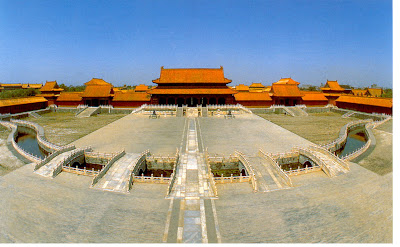The Forbidden City is:
- the best-preserved imperial palace in China,
- the largest ancient palatial structure in the world, and
- the essence and culmination of traditional Chinese architectural accomplishment.
International Recognition
- In 1961 the Forbidden City was listed as an important historical monument under Chinese central government special preservation.
- In 1987, it was nominated as World Cultural Heritage by UNESCO. The Palace Museum is a treasure house of Chinese cultural and historical relics.
- It is recognized as one of the most important five palaces in the world (the other four are the Palace of Versailles in France, Buckingham Palace in the UK, the White House in the US, and the Kremlin in Russia).
History
The construction of the grand palace started in the fourth year of Emperor Yongle of the Ming Dynasty (1406), and ended in 1420.
In ancient times, the emperor was said to be a son of Heaven, and
therefore Heaven’s supreme power was bestowed upon him. The emperors’
residence on earth was built as a replica of the Purple Palace where God was thought to live in Heaven.
Names: Such a divine place was certainly forbidden to
ordinary people and that is why the Forbidden City is so named.
Originally called Zijin
Cheng ('Purple Forbidden City'), in China now it is usually called Gugong (故宫 /goo-gong), the 'Former/Old Palace'.
Features
To
represent the supreme power of the emperor given from God, and the
place where he lived being the center of the world, all the gates,
palace and other structures of the Forbidden City were arranged about the north-south central axis of old Beijing.
For security the Forbidden City is enclosed by a 10-meter-high defensive wall,
which has a circumference of 3, 430 meters. At each corner of the
Forbidden City, there stands a magnificent watchtower, which was heavily
guarded in the past. Around the city there is a moat as the first line
of defense. See our Forbidden City Map.
The Forbidden City covers an area of about 72 hectares (178 acres) with
a total floor space of approximately 150,000 square meters (1,600,000
square feet). It consists of 90 palaces and courtyards, 980 buildings and 8,704 rooms.
A Typical Forbidden City Guided Tour
Any tour of Beijing would be incomplete without a visit to the Forbidden City.
Entrance
Most travelers enter the Forbidden City through Tian'anmen, the Gate of Heavenly Peace. Through the gate, across an expansive brick-paved square, you will reach the main entrance to the palace, Meridian Gate (Wumen in Chinese).
 |
| Tian'anmen |
Meridian Gate was the place where the Emperor
announced the new lunar calendar on the winter solstice. Enter through
Meridian Gate, and go across Golden Stream Bridge, then you will arrive
at the outer court. The Forbidden City falls into two parts: the outer
court and the inner palaces.
The Outer Court
The outer court is made up of three main buildings, the Hall of Supreme Harmony (Taihedian), the Hall of Central Harmony (Zhonghedian) and the Hall of Preserving Harmony (Baohedian). These halls were where the emperors attended the grand ceremonies and conducted state affairs.
The first hall waiting for you is the Hall of Supreme Harmony, the most important and largest structure in the Forbidden City. The emperors' Dragon Throne (Longyi) is in this hall.
Behind the Hall of Supreme Harmony is the Hall of Central Harmony
(Zhonghedian), the resting place of the emperor before presiding over
grand events held in the Hall of Supreme Harmony. Emperors would
rehearse their speeches and presentations here before departing to the
Temple of Heaven for the sacrifice rites.
The last hall is the Hall of the Preserving Harmony used for banquets and later for imperial examinations.
There are a couple of side gardens with interesting halls to explore.
Please consult with your local guide if you want to visit them. It will
take more time to walk around the palace.
Out from the Hall of the Preserving Harmony, you will notice a huge
block of marble carved with cloud and dragon designs. Go straight, and
you will see another gate, called the Gate of Heavenly Peace (Qianqingmen). This is the main gateway to the inner living court.
The Inner Court
The first structure inside the inner court is the Palace of Heavenly Peace, the emperors' sleeping quarters. Behind it is the Palace of Union and Peace, where the imperial seals were stored. The third hall is the Hall of Terrestrial Tranquility, the emperors' wedding room.
Besides the three main buildings there are the six eastern palaces and six western palaces,
where the emperor used to handle everyday affairs, and which was the
living quarters of the emperor, expresses and concubines. Those palaces
have been converted into exhibition halls, where a spectacular set of
imperial collections is displayed.
Exiting and going further north, travelers will find the Imperial Garden. The garden offers an aesthetic change from the crimson and gray building complex to a colorful and luxuriant atmosphere.
On the left side of the inner court, travelers will find the Mental Cultivation Hall
(Yangxindian), the most important building except for the Hall of
Supreme Harmony. From the time of the third emperor, Yongzhen, all the
Qing emperors, 8 in total resided in this hall.
Exit
The main exit gate of the Forbidden City is the Gate of Divine Might, behind the Imperial Garden.
 |
| Gate of Divine Might |
source: chinahighlights


0 comments:
Post a Comment